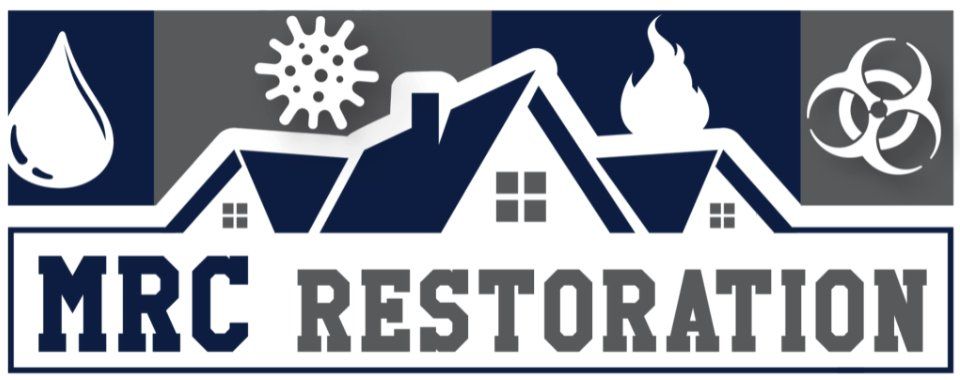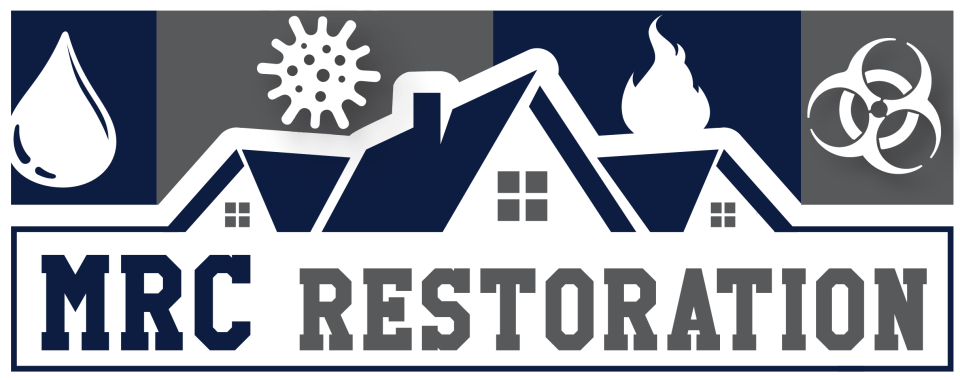Call the Trusted Local Leader Today!
Leaks in Ceilings and Walls
Expert Water Leak Cleanup: Ceiling and Wall Damage Restoration by MRC Restoration
As homeowners, it's crucial to be vigilant for signs of water damage, as prompt identification and action can prevent further deterioration and costly repairs. Ceilings often exhibit telltale indicators such as peeling, bubbling, or flaking paint, hairline cracks or spiderwebbed patterns, water rings, mold growth, sagging or bowed surfaces, and unsightly stains. Walls may display softened, depressed drywall, discoloration streaks, water rings, cracked or bubbling paint, and musty odors. Floors can reveal buckling, warping, discoloration, cupping or crowning of planks, and unpleasant smells.
However, some signs of water damage can be hidden from plain sight. Be alert for:
- Mold growth in seams or corners
- Unexplained spikes in water utility bills
- Persistent stains or discoloration
- Musty odors
- Warped, buckled, or misshapen surfaces
- Peeling paint or wallpaper
When dealing with ceiling water damage, it's crucial to identify the water leaking from ceiling source, stop the leak, and then repair or replace the damaged ceiling as needed.Ceiling leak repair may be covered by homeowners insurance if the cause is not due to flooding, poor maintenance, or faulty repairs, so checking with your insurance provider is advisable.

Get A Free Quote
For more information or to schedule service, complete the form below or call us at (573) 315-6143.
Contact Us
We will get back to you as soon as possible.
Please try again later.
Common Causes
- There are several common causes that can lead to water leaking from ceiling and wall damage in your home. Understanding the source of the leak is crucial for effective repair and restoration.Roof Issues: Leaks or damage to the roof can allow water to seep through and drip down into the ceiling . This could be due to missing or damaged shingles, flashing problems, or other roofing issues.
- Plumbing Problems: Leaks in pipes or plumbing fixtures, such as showers, tubs, or sinks, can cause water to drip down into the ceiling or walls [6]. <secondary_keyword>Water leaking from ceiling vent or water leaking from vent in ceiling could also indicate a plumbing issue.
- Condensation and HVAC Issues: High indoor humidity combined with a cooler ceiling temperature can lead to condensation forming on the ceiling, resulting in water drips [7]. Additionally, issues with the HVAC system, such as leaks or improper drainage, can contribute to water damage.
- Gutter and Drainage Problems: Clogged gutters or improper drainage can cause water to back up and potentially leak through the roof and into the ceiling [7].
- Shower or Bathroom Leaks: Water leak in ceiling below bathroom or bathroom ceiling leak could be caused by improper shower floor installation, lack of waterproofing, or other issues in the bathroom .
The location and timing of the leak can provide valuable clues about the source. For instance, leaks during or after rain may indicate a roof issue, while constant leaks could point to a plumbing problem. Water stains,water bubble in ceiling, or water in ceiling are also signs that should not be ignored.
Drying Techniques
Proper drying techniques are crucial for effective water damage restoration. We employ a strategic approach to ensure complete dryness and prevent further issues like mold growth. Here's how we tackle the drying process:
- Dehumidification: Our team utilizes industrial-grade dehumidifiers to remove excess moisture from the affected area. These powerful machines work continuously to lower humidity levels, creating an environment unfavorable for mold proliferation.
- Air Circulation: In tandem with dehumidifiers, we strategically position high-velocity air movers and fans to promote air circulation. This two-pronged approach accelerates the drying process, ensuring that every nook and cranny is thoroughly dried out.
- Heat Application: In certain cases, we employ heat guns or specialized drying equipment to expedite the drying of setting compounds, such as drywall mud or joint compound. Controlled heat application can significantly reduce the overall drying time.
- Ventilation: Whenever possible, we open windows and doors to facilitate cross-ventilation, allowing fresh air to circulate and aid in the drying process.
Throughout the drying phase, our technicians closely monitor moisture levels using specialized meters and sensors. This meticulous approach ensures that the affected areas are completely dry before proceeding with the restoration and repair stages.
Water leaking from ceiling or water in ceiling situations can be challenging, but our comprehensive drying techniques, combined with state-of-the-art equipment, guarantee a thorough and efficient resolution.
Restoration and Repair
Once the drying process is complete, it's time to focus on restoring and repairing the affected areas. Here's how we approach this crucial phase:
- Assess the Damage: Our technicians thoroughly inspect the dried areas to evaluate the extent of the damage. This assessment helps determine the appropriate restoration and repair methods.
- Removal and Disposal: Depending on the severity of the damage, we carefully remove any waterlogged or compromised materials, such as drywall, insulation, or flooring. These materials are properly disposed of to prevent further contamination or health hazards.
- Mold Remediation: If mold growth is detected, we implement comprehensive mold remediation protocols to ensure a safe and healthy environment. This may involve:
- Applying antimicrobial treatments
- Physically removing mold-infested materials
- Utilizing specialized equipment like air scrubbers and HEPA vacuums
Frequently Asked Questions
About Leaking Ceilings and Walls
-
What should I do if my ceiling is leaking?
If you see water running from the ceiling, paint bubbling, brown rings, or drywall swelling then you have a water leak in your ceiling but before anything is repaired here are some steps to prevent water from spreading and causing additional damage.
1. Get something to contain the water. If there is water running from the ceiling, then getting one or more waterproof containers to catch the water prevents it from flooding the home and damaging floors.
2. Move or cover any furniture that may be near the leak. It is preferred that all furniture and décor be removed from the area but if something is unable to be moved then covering with waterproofing covering can prevent damage to furniture.
3. Soak up any water that is on the floor. Soaking up standing water on the floor with a mop or old towels can help prevent the flooring from warping or developing mold problems.
4. Make a small hole in the ceiling for drainage. This may seem contradictory as it will allow water to drain more quickly but it will help control the water downward in a place where you can catch it. This prevents water from spreading through your ceiling down into your drywall and electrical.
5. Call a plumber or roofer. If possible, determine if the leak is coming from your roof or plumbing issues. If it is not raining and you are experiencing a leak its more than likely a plumbing issue and you will need a plumber not a roofer
-
Is a leaking ceiling or wall an emergency?
The simple answer is yes. A water leak on your ceiling or wall is an emergency because it indicates that there is water flowing through your home where water should not be. Water spots on your ceiling can also mean water is flowing down your walls encountering electrical and causing hidden damage such as mold. Excess water and moisture can get absorbed into your drywall, wood, insulation, and wallpaper. This instance will lead to warping in walls, water stains, deterioration, and mold growth. If a leak is hidden behind walls mold can easily grow in areas that are not easily detected causing health issues like allergies to those exposed. Another concern with water behind your walls is it connects with electrical wires, this can cause short circuits and in extreme cases electrical fires. If a water leak is found behind a wall it is best to leave it to professionals as they have the means to handle the job effectively and safely.
-
How much does it cost to fix a leak in the ceiling?
The cost to repair damages is determined by the size of the area that was damaged and how long the leak was present. A rough estimate to repair a ceiling leak could be anywhere from $500 to $2000 so it is best to address the problem as soon as it is discovered to prevent additional repair costs.
-
Are ceiling leaks covered by homeowners’ insurance?
Homeowners insurance will cover ceiling leaks if they occur accidentally or suddenly by a covered peril. Slow leaks or lack of maintenance may not be covered under insurance it is best to contact the homeowner's agent and see what is covered under the policy.
-
Should you poke a hole in a leaking ceiling?
Yes, poking a hole in a leaking ceiling will direct the water downward and into a waterproof container, you place under the hole. Poking a hole in the ceiling will prevent water from flowing through your ceiling and walls causing additional damage that may go unseen.
-
How do you dry a ceiling after a leak?
Experts recommend using dehumidifiers and high-volume fans in the closed-off area to quickly dry water-damaged drywall to help prevent mold growth. When drying a water-damaged area, it is best to leave it to professionals who have the correct equipment to dry the area as quickly as possible to prevent further damage.
-
Saint Francois County
- Farmington
- Park Hills
- Bonne Terre
- Desloge
- Leadwood
- Bismarck
- Iron Mountain Lake
- Doe Run
- Terre du Lac
- French Village
-
Jefferson County
- Arnold
- Festus
- Imperial
- Hillsboro
- De Soto
- Pevely
- Herculaneum
- Barnhart
-
Washington County
- Potosi
- Mineral Point
- Caledonia
- Irondale
- Belgrade
- Cadet
- Richwoods
- Shirley
- Tiff
- Blackwell
-
Madison County
- Fredericktown
- Marquand
- Cobalt Village
-
Iron County
- Ironton
- Pilot Knob
- Arcadia
- Viburnum
- Annapolis
- Des Arc
- Glover
- Belleview
- Middle Brook
A Bit About Us
Why Hire Us?
1
Each Crew is IICRC Trained & Certified
2
Recommended by Insurance Providers
3
99.9% Satisfaction Rating
4
Google Rating of 5.0 from 40+ Reviews
GET A FREE QUOTE
When disaster strikes, you need to make sure your home or business is restored back to its original state. Our team of professionals will get to work quickly and efficiently to fix any issues caused by water damage. Rest easy knowing the job is in the right hands with MRC Restoration. Our skilled professionals are here to help you every step of the way. Making your life better is our priority.
MRC Restoration Provides Peace of Mind, in Uncertain Times.
When tough times hit, it's natural to feel overwhelmed. At MRC Restoration, we're here to support you through every step of the journey. We collaborate with your family to evaluate the situation, craft a personalized strategy, and execute it with precision, restoring your home or business to its former glory.

For Both Residential & Commercial Water cleanup, Fire and Smoke Damage Repair & Mold Remediation Services, Call the Trusted Local Leader Today for Your Evaluation!
Service Area
Services
Hours
Friday - Open 24 hours
Saturday: Open 24 hours
Sunday: Open 24 hours
Monday: Open 24 hours
Tuesday: Open 24 hours
Wednesday: Open 24 hours
Thursday: Open 24 hours
All Rights Reserved | MRC Restoration

